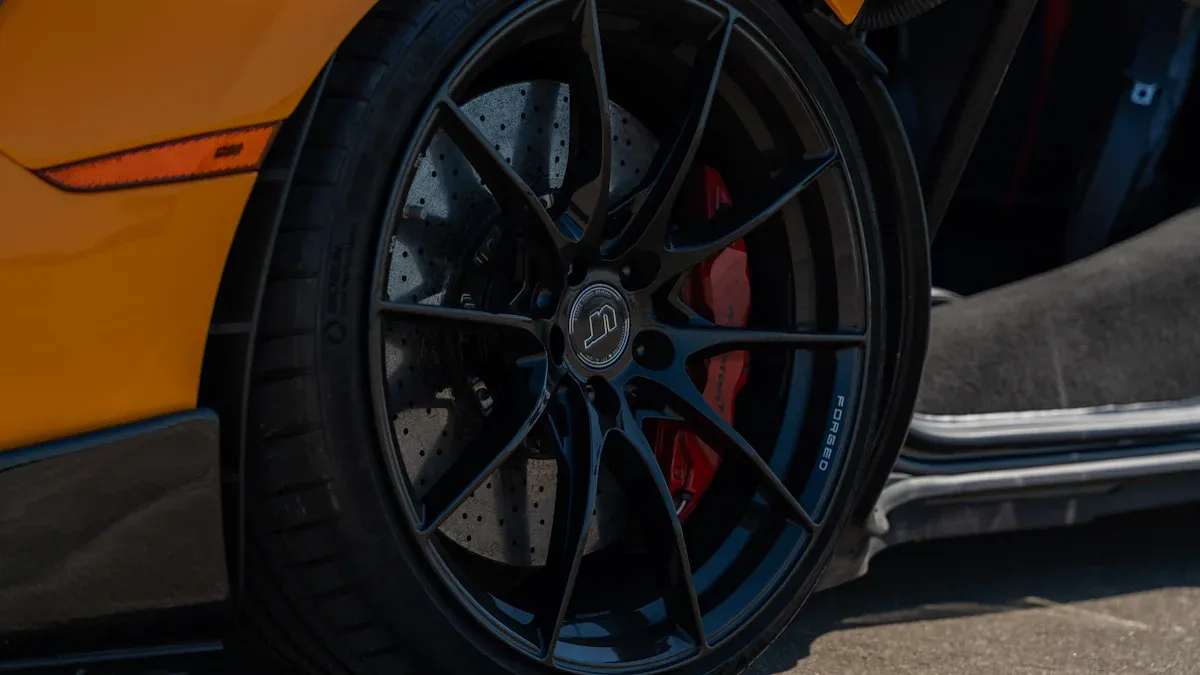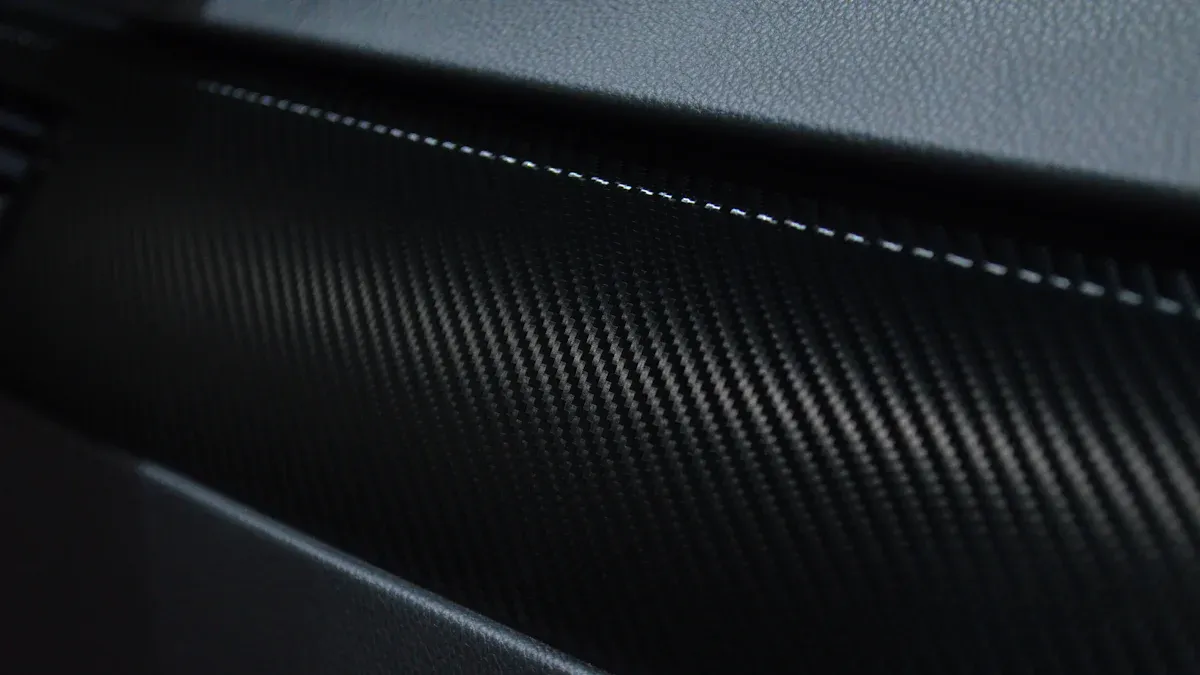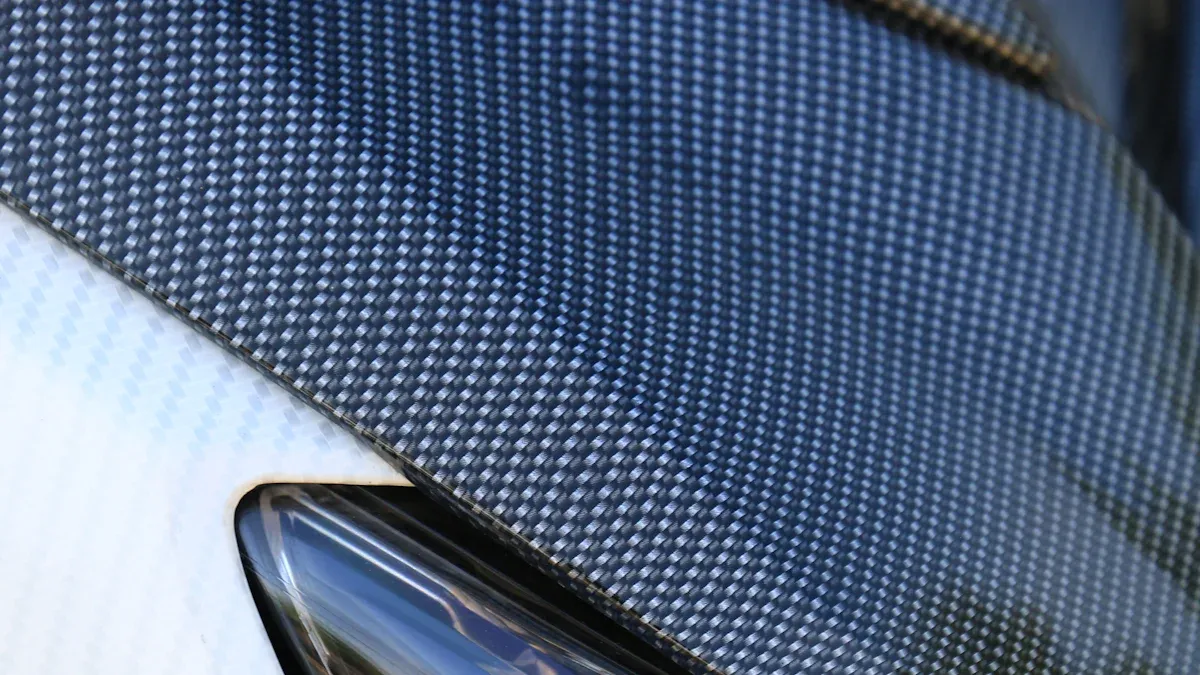
Injection molding plays a vital role in shaping the future of carbon fiber auto parts. It allows you to create lightweight and high-performance components that meet the growing demand for fuel efficiency and electric vehicles. The automotive lightweight materials market is expected to grow from $120.2 billion in 2024 to $131.08 billion in 2025, highlighting the increasing reliance on advanced materials.
Staying competitive in 2025 requires embracing advancements in automotive injection molding. The global injection molding market, valued at $295 billion in 2024, is projected to reach $451.83 billion by 2033. This growth reflects the need for better machinery, sustainable practices, and innovative designs. Recycled carbon fiber also offers a pathway to reduce waste while maintaining performance, ensuring a greener future for the automotive industry.

Carbon fiber composites offer a unique combination of properties that make them ideal for automotive applications. These materials are lightweight, strong, and versatile, enabling manufacturers to meet modern performance and efficiency demands. The table below highlights the key performance metrics of carbon fiber composites:
| Performance Metric | Description |
|---|---|
| Lightweight material | Carbon fiber is about five times lighter than steel, aiding in weight reduction and fuel efficiency. |
| High strength-to-weight ratio | Stronger than steel yet lighter, providing necessary strength without added weight. |
| Increased fuel efficiency | Lighter cars require less fuel, crucial for modern automotive design. |
| Enhanced performance and handling | Improves speed and agility, offering better handling and stability for high-performance vehicles. |
| Improved crashworthiness | Excellent energy absorption properties enhance vehicle safety. |
Additionally, carbon fiber composites exhibit:
- High rigidity and structural stability.
- Corrosion resistance, ensuring longevity.
- Versatility in shaping, allowing for innovative designs.
Carbon fiber plays a critical role in reducing vehicle weight while maintaining strength. For instance, carbon fiber reinforced plastic (CFRP) components weigh 50-70% less than steel and are 30% lighter than aluminum, all while offering comparable strength. This weight reduction directly improves fuel efficiency and vehicle performance. Moreover, carbon fiber parts provide 2 to 5 times more strength than aluminum parts of the same weight, making them ideal for high-performance and safety-critical applications.
By incorporating carbon fiber into automotive composites, manufacturers can create vehicles that are not only lighter but also safer and more agile. This combination of benefits is essential for meeting the demands of modern automotive design.
Despite its advantages, carbon fiber faces challenges in automotive applications. High material costs remain a significant barrier. While manufacturing costs for composites may be lower than steel, the initial investment in carbon fiber is substantial. This can deter manufacturers from adopting it widely.
The fragmented supply chain also complicates integration. Many suppliers focus on specialized technologies that may not align with automotive needs. However, the value derived from carbon composites, such as improved safety and part consolidation, can offset these costs if customers recognize their benefits. Addressing these challenges will be crucial for expanding the use of carbon fiber in the automotive industry.
Injection molding is a manufacturing process that allows you to produce complex automotive parts with high precision. The process begins by heating thermoplastic materials until they melt. The molten material is then injected into a mold cavity under high pressure. Once the material cools and solidifies, the mold opens, and the finished part is ejected. This method is widely used in automotive parts production due to its efficiency and ability to create consistent, high-quality components.
In automotive injection molding, you can achieve intricate designs and tight tolerances, which are essential for modern vehicles. The process also supports high-volume production, making it ideal for manufacturing large quantities of parts like bumpers, dashboards, and structural components. By optimizing parameters such as temperature, pressure, and cooling time, you can enhance the quality and durability of the final product.
When working with carbon fiber in injection molding, you must account for several unique challenges. Unlike traditional materials, carbon fiber composites require enhanced venting to manage gases during the molding process. For long-fiber reinforced composites, venting needs to be twice as effective compared to unreinforced materials. Additionally, the fiber content in these composites can reach up to 50% for carbon fibers, which impacts the polymer matrix's behavior.
Preserving fiber length is critical for maintaining the mechanical advantages of carbon fiber. Excessive fiber breakage during processing can reduce the strength and stiffness of the final part. To address this, you should carefully control processing conditions, such as injection speed and pressure, to minimize fiber damage. These adjustments ensure that the benefits of fiber optimization, such as improved strength-to-weight ratios, are fully realized.
Mold design plays a crucial role in automotive injection molding. A well-designed mold ensures uniform material flow, which prevents defects like weld lines and voids. Key parameters such as flow paths, pressure distribution, and cooling rates directly impact the quality and efficiency of automotive parts production. For example:
| Aspect | Description |
|---|---|
| Flow Paths | Analyzes the routes taken by molten plastic, crucial for ensuring uniform filling of the mold. |
| Pressure Distribution | Evaluates the pressure exerted during the injection process, affecting part quality and integrity. |
| Cooling Rates | Assesses how quickly the material cools, impacting cycle time and dimensional accuracy. |
By understanding these parameters, you can optimize mold design to enhance production efficiency and reduce errors. For instance, analyzing flow paths helps you predict issues like insufficient filling, while managing cooling rates ensures dimensional accuracy. These steps not only improve part quality but also reduce production costs, making your process more competitive.
Controlling fiber alignment is essential for achieving the desired mechanical properties in carbon fiber auto parts. During injection molding, the flow of molten material determines how fibers align within the polymer matrix. Proper alignment enhances strength, stiffness, and durability, while misalignment can lead to weak points and defects. You can use several techniques to optimize fiber alignment and minimize defects:
Maintaining fiber length is equally important. Shortened fibers lose their reinforcing properties, compromising the part's strength. By carefully managing processing conditions, you can preserve fiber length and ensure the final product meets performance requirements.
Balancing strength and weight is a critical challenge in automotive manufacturing. Multi-objective optimization allows you to achieve this balance by fine-tuning various parameters during the injection molding process. For example, you can adjust the fiber volume fraction to enhance strength without adding unnecessary weight. Higher fiber content increases stiffness and durability, but excessive amounts can lead to processing difficulties.
You can also experiment with different polymer matrices to find the best combination of strength, weight, and durability. Advanced simulation tools help predict how changes in material composition and processing conditions will affect the final product. These tools allow you to test multiple scenarios, saving time and resources while achieving optimal results.
Recycled carbon fiber offers a sustainable alternative to virgin materials, reducing waste and environmental impact. By incorporating recycled fibers into injection molding processes, you can create high-performance auto parts while supporting eco-friendly practices. For instance, CompLam blends recycled carbon with PA66 plastic recovered from the ocean. This innovative resin contains 12% to 20% recycled carbon, demonstrating how sustainable materials can meet automotive standards.
Recycling thermoset epoxy-based carbon fiber composites prevents landfill waste and recovers valuable materials from end-of-life products. Although recycled composites may exhibit slightly lower mechanical properties than virgin materials, they still provide sufficient strength and durability for many applications. The table below highlights the differences between virgin and recycled composites:
| Property | Virgin Composite | Recycled Composite | Difference |
|---|---|---|---|
| Shear Strength | 125 MPa | 115 MPa | 7% lower |
| Compression Strength After Impact | N/A | 33% decrease | Decrease noted |
| Shear Modulus | N/A | 20% lower | Reduction noted |
The tensile properties of recycled composites depend on fiber length and volume fraction. While tensile strength and modulus decrease with shorter fibers, strain-to-failure remains higher than in commercial compounds. This suggests that recycled carbon fiber can still deliver excellent performance when processed correctly.
By leveraging recycled carbon fiber, you not only reduce costs but also contribute to a greener future. Sustainable manufacturing practices align with industry trends and consumer expectations, making them a smart choice for high volume production.

The automotive injection molding industry is evolving rapidly, with new machinery and equipment designed to meet the demands of 2025. These innovations focus on improving efficiency, precision, and sustainability. You can expect the following advancements to shape the future of injection molding:
| Innovation Type | Description |
|---|---|
| Electric and Hybrid Drive Systems | These systems enhance efficiency and reduce energy consumption in injection molding processes. |
| Smart Factory Integration | Incorporates IoT and automation for improved operational efficiency and data management. |
| Advanced Process Control Systems | Provides real-time monitoring and adjustments to optimize production quality and speed. |
The automotive sector drives demand for high-precision injection molding machines. Lightweight materials and complex components are becoming essential in modern vehicle designs. As a result, manufacturers are adopting advanced machinery to produce parts like interior trim and exterior body panels. This trend is expected to fuel steady growth in the injection molding machine market. By embracing these innovations, you can stay competitive and meet the rising demand for high-performance plastic parts.
Predictive software tools are transforming how you approach design and testing in injection molding. These tools use advanced algorithms to simulate and predict outcomes, helping you make informed decisions before production begins. For example, predictive software can estimate the tonnage required for molds based on input parameters like part thickness and pressure settings. If a part has a thickness of 0.60 inches, the software might predict a tonnage of 89.76 tons. When the thickness increases to 0.80 inches, the prediction adjusts to 78.96 tons. This adaptability ensures accuracy and reduces trial-and-error during the design phase.
By using predictive tools, you can optimize material usage, minimize defects, and improve overall efficiency. These tools also allow you to test multiple scenarios virtually, saving time and resources. As a result, you can achieve better product quality while reducing production costs. Predictive software is becoming an indispensable asset for manufacturers aiming to stay ahead in the competitive automotive market.
Automation and energy efficiency are key to optimizing injection molding processes. Smart manufacturing technologies, such as real-time data analytics and energy-efficient machines, are helping you achieve higher productivity while reducing energy consumption. Electric injection molding machines, for instance, consume less energy compared to traditional hydraulic machines. This makes them ideal for automotive applications where energy optimization is crucial.
The global market for automated injection molding machines is projected to grow steadily, with a compound annual growth rate (CAGR) of 1.4% from 2025 to 2033. This growth reflects the increasing demand for lightweight and high-precision components. Emerging trends in automation, such as Industry 4.0, are further driving this adoption. Real-time process monitoring and machine learning-based predictive maintenance are becoming standard practices. These technologies enhance efficiency, reduce operational costs, and ensure consistent product quality.
By integrating automation and energy-efficient solutions into your processes, you can stay competitive in a rapidly evolving industry. These advancements not only improve production efficiency but also align with sustainability goals, making them a smart choice for the future of automotive injection molding.
Reducing cycle times and production costs is essential for improving efficiency in automotive injection molding. You can achieve this by optimizing process parameters and adopting advanced technologies. For example, adjusting cooling times and injection speeds can significantly enhance production rates. Automation also plays a key role in streamlining operations and minimizing human error.
The table below highlights key metrics that demonstrate how process improvements can lead to better outcomes:
| Improvement Metric | Result |
|---|---|
| Cycle time reduction | 10% (4.2 seconds faster) |
| Increased output per year | 11% more output |
| Shorter reprint time | 32% (from 14 to 9.5 seconds) |
| Production cost reduction per component | 4.2% |
| Stable quality | Fewer process fluctuations |
| Energy efficiency | Lower energy consumption |
By focusing on these metrics, you can enhance cost efficiency while maintaining high-quality standards.
Mold durability is critical for consistent production quality. To extend mold life, you should prioritize regular maintenance and cleaning. Removing residue and inspecting for wear can prevent defects like flash or warping. Using high-quality materials for molds also reduces the risk of damage during high-pressure injection.
Preventing defects requires careful attention to mold design and material flow. Ensure uniform cooling by optimizing the placement of cooling channels. This reduces the likelihood of warping or shrinkage. Additionally, venting systems help eliminate trapped air, which can cause voids or weak spots in the final product. By implementing these practices, you can maintain mold integrity and produce defect-free parts.
Balancing sustainability with performance is a growing priority in automotive manufacturing. Carbon fiber reinforced polymer (CFRP) composites offer a unique solution. These materials reduce vehicle weight, leading to lower fuel consumption and emissions throughout the vehicle's life cycle. Strategic choices in material composition and manufacturing processes further enhance sustainability.
For example, using recycled carbon fiber reduces waste without compromising performance. While recycled composites may have slightly lower mechanical properties, they still meet the demands of many automotive applications. CFRP also outperforms traditional materials like aluminum in terms of weight savings and efficiency. By adopting sustainable practices, you can achieve both environmental and performance goals.
Mastering injection molding for carbon fiber auto parts is essential to meet the demands of 2025. Lightweight materials like carbon fiber improve vehicle performance and fuel efficiency. Stricter emissions regulations and advancements in manufacturing make this technology even more critical.
Here’s why injection molding is vital for the future:
| Key Factor | Description |
|---|---|
| Weight Reduction | Carbon fiber is 30% lighter than metal, enhancing vehicle performance through improved acceleration and fuel efficiency. |
| Aerodynamic Efficiency | Well-designed carbon fiber components can increase downforce by up to 25%, crucial for high-speed stability in sports cars. |
| Technological Advancements | Innovations in manufacturing processes reduce costs and improve quality, increasing adoption among luxury automakers. |
| Regulatory Standards | Stricter emissions regulations drive the need for lightweight materials like carbon fiber in automotive designs. |
| Aesthetic Appeal | Carbon fiber is perceived as a symbol of luxury and performance, appealing to high-end vehicle markets. |
To stay competitive, you must embrace advancements in machinery, predictive tools, and sustainable practices. Recycled carbon fiber offers a greener path forward, aligning with industry trends. By optimizing your processes and adopting innovative solutions, you can lead the way in automotive manufacturing.
Looking ahead, the role of carbon fiber in creating efficient, sustainable, and high-performance vehicles will only grow. Your ability to adapt and innovate will define your success in this evolving industry.
Carbon fiber offers a high strength-to-weight ratio, making it perfect for lightweight and durable auto parts. Its rigidity and corrosion resistance enhance performance and longevity. Injection molding ensures precision and efficiency when shaping these advanced materials.
You can reduce defects by optimizing injection speed, pressure, and gate design. Proper mold venting and cooling systems also prevent issues like voids or warping. These adjustments ensure consistent quality in your final product.
Recycled carbon fiber provides sufficient strength for many applications, though it may have slightly lower mechanical properties. It offers a sustainable and cost-effective alternative, aligning with eco-friendly manufacturing goals.
Automation improves efficiency by reducing cycle times and minimizing errors. It enables real-time monitoring and predictive maintenance, ensuring consistent quality. Energy-efficient machines also lower operational costs, making your process more competitive.
Yes, predictive software helps you simulate and optimize designs before production. It reduces trial-and-error, saving time and resources. These tools also enhance material usage and minimize defects, ensuring better outcomes for your automotive parts.